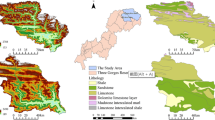Abstract
Dynamic changes of soil erosion affected by conversion of farmland to forest or grassland in the Yanhe River Basin were analyzed based on the revised universal soil loss equation (RUSLE). The RUSLE variables were selected and calculated reasonably using the GIS technique. Results show that: 1) After the conversion of farmland to forest or grassland, soil erosion decreased greatly. Compared with soil erosion in period of 1986 to 1997, the soil erosion amount had been reduced on the average by 30.6% by 2000; 2) Of the different land uses, slope farmland, especially the steep slope land had the greatest impact on soil erosion. The conversion of forest or grassland was the main driving force for the reduction of soil erosion; 3) In the short term, soil erosion was mainly controlled by C-factor, implying that the adjustment of land use structure might be an effective approach to reduce soil erosion.
Similar content being viewed by others
References
Fu B J, Qiu Y (2000). Land evaluation for sustainable use based on landscape ecologic theory. Resour Sci, 22(6): 1–8 (in Chinese)
Fu B J, Zhao W W, Chen L D (2005). Assessment of soil erosion at large watershed scale using RUSLE and GIS: A case study in the Loess Plateau of China. Land Degrad Dev, 16: 73–85 (in Chinese)
Hartemink A E (1998). Soil chemical and physical properties as indicators of sustainable land management under sugar cane in Papua New Guinea. Geoderma, 85: 283–306
Leng S Y, Li X B (1999). New progresses of international study on land quality indictors (LQIs). Acta Geogr Sin, 54(1): 177–185 (in Chinese)
Liu B Y, Nearing M A, Risse L M (1994). Slope gradient effects on soil loss for steep slopes. Transact ASAE, 37(6): 1835–1840
Lufafa A, Tenywa M M, Isabirye M (2003). Prediction of soil erosion in a Lake Victoria basin catchment using GIS based Universal Soil Loss model. Agr Sys, 76: 883–984
Peel T C (1937). The relation of certain physical characteristics to the erodibility of soils. Soil Sci Soc Proceed, 2: 79–84
Renard K G, Foster G R, Weesies G A (1997). Predicting Soil Erosion by Water: A Guide to Conservation Planning with the Revised Universal Soil Loss Equation (RUSLE). Washington: US Department of Agriculture, 404–407
Renard K G, Freimund J R (1994). Using monthly precipitation data to estimate the R-factor in the revised USLE. J Hydr, 157: 287–306
Shangguan Z P (2006). Consideration on soil and water conservation and ecological restoration in the Loess Plateau. Sci Soil Water Conserv, 4(1): 1–4 (in Chinese)
Tang K L (2004). Soil and Water Conservation of China. Beijing: Science Press (in Chinese)
Tian J L, Liang Y M, Liu P L (2003). Research of Ecological Agriculture Construction at Middle Scale on Hilly Area in the Loess Plateau. Zhenzhou: Water Conservancy Publisher of the Yellow River (in Chinese)
van Remortel R, Hamilton M, Hickey R (2001). Estimating the LS factor for RUSLE through iterative slope length processing of digital elevation data. Cartography, 30(1): 27–35
Wang B W, Yang Q K, Liu Z H (2007). Extraction of RUSLE-LS factors using data and GIS techniques. Sci Soil Water Conserv, 5(2): 18–23 (in Chinese)
Wang W Z, Jiao J Y (1996). Quantitative evaluation on factors influencing soil erosion in China. Bull Soil Water Conserv, 16(5): 1–20 (in Chinese)
Yang D W, Kanae S J, Oki T K (2003). Global potential soil erosion with reference to land use and climate changes. Hydrol Proc, 17: 2913–2928
Zhang Y, Liu B Y, Shi P J (2001). Crop cover factor estimating for soil loss prediction. Acta Ecol Sin, 27(7): 1050–1056 (in Chinese)
Zheng F L, Yang Q K, Wang Z L (2004). Water erosion prediction model. Res Soil Water Conserv, 11(4): 13–24 (in Chinese)
Author information
Authors and Affiliations
Corresponding author
Additional information
__________
Translated from Science of Soil and Water Conversation, 2007, 5(4): 27–33 [译自: 中国水土保持科学]
About this article
Cite this article
Wang, B., Yang, Q. & Liu, Z. Effect of conversion of farmland to forest or grassland on soil erosion intensity changes in Yanhe River Basin, Loess Plateau of China. Front. For. China 4, 68–74 (2009). https://doi.org/10.1007/s11461-009-0015-5
Published:
Issue Date:
DOI: https://doi.org/10.1007/s11461-009-0015-5




